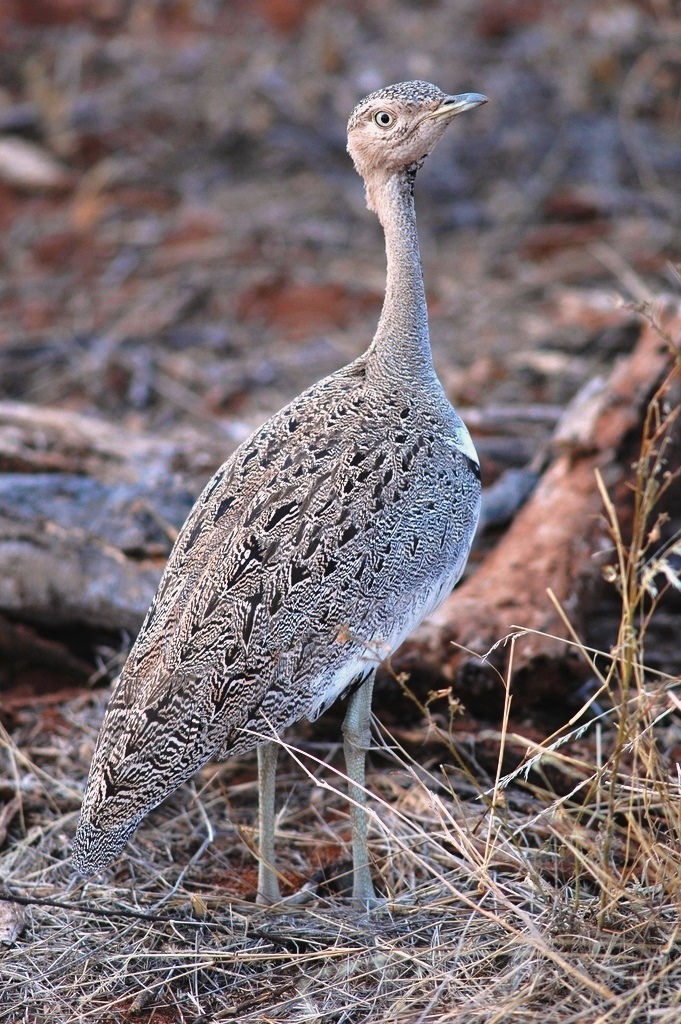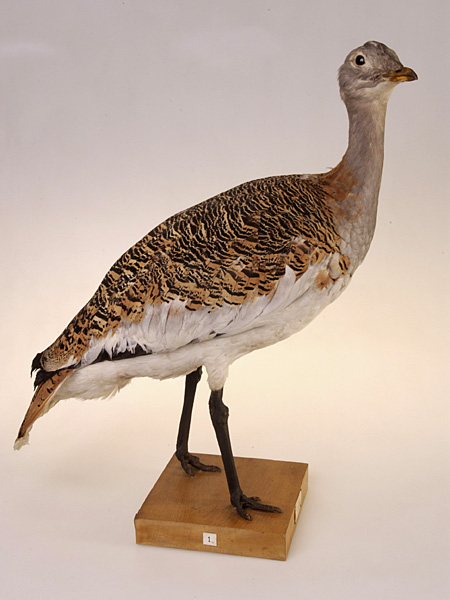|
Otididae
Bustards, including floricans and korhaans, are large, terrestrial birds living mainly in dry grassland areas and in steppe regions. They range in length from . They make up the family Otididae (, formerly known as Otidae). Bustards are omnivorous and opportunistic, eating leaves, buds, seeds, fruit, small vertebrates, and invertebrates.del Hoyo, J. Elliott, A. & Sargatal, J. (editors). (1996) ''Handbook of the Birds of the World. Volume 3: Hoatzin to Auks''. Lynx Edicions. There are 26 species currently recognised. Etymology The word ''bustard'' comes from the Old French ''bistarda'' and some other languages: ''abetarda'' ( pt), ''abetarda'' ( gl), ''avutarda'' ( es) used for the great bustard. The naturalist William Turner listed the English spelling "bustard" and "bistard" in 1544. All of the common names above are derived from Latin ''avis tarda'' or ''aves tardas'' given by Pliny the Elder, these names were mentioned by the Pierre Belon in 1555 and Ulisse ... [...More Info...] [...Related Items...] OR: [Wikipedia] [Google] [Baidu] |
Chlamydotis
'' Chlamydotis '' is a genus of large birds in the bustard family. The genus name is from Ancient Greek ''khlamus'', a horseman's cloak with weights sewn into the corners, and ''otis'', bustard. Members of this genus show very little sexual dimorphism in their plumage. The clade consists of two extant species, formerly considered to be conspecific forms a sister group within the clade that includes the genus ''Otis''. The genus was established by the French naturalist René Primevère Lesson in 1839 and included only one species which was formerly described in the genus ''Otis''. The genus name of ''Houbara'' was used by Charles Lucien Bonaparte but this was dropped, being a ''nomen nudum'', as not following the requirements for zoological names. The Asian houbara was split on the basis of distinctive display, differences in feather colours and on the basis of well established genetic differences. The two species are thought to have separated during a period of extreme ar ... [...More Info...] [...Related Items...] OR: [Wikipedia] [Google] [Baidu] |
Afrotis
''Afrotis'' is a genus of bustard in the family Otididae. The genus is endemic to southern Africa, and contains two species. It is sometimes included in the genus ''Eupodotis ''Eupodotis'' is a genus of bird in the bustard family Otididae. It contains two species, all restricted to Africa. Species in the genera ''Afrotis'' and ''Lophotis'' are sometimes included in this genus; however some authorities separate the Kar ...''. Species References Birds of Southern Africa Taxa named by George Robert Gray Bird genera {{Otidiformes-stub ... [...More Info...] [...Related Items...] OR: [Wikipedia] [Google] [Baidu] |
Eupodotis
''Eupodotis'' is a genus of bird in the bustard family Otididae. It contains two species, all restricted to Africa. Species in the genera ''Afrotis'' and ''Lophotis'' are sometimes included in this genus; however some authorities separate the Karoo korhaan, Rüpell's Korhaan and little brown bustard as a separate genus ''Heterotetrax''. Species References Eupodotis, Bird genera Birds of Sub-Saharan Africa Taxa named by René Lesson Taxonomy articles created by Polbot {{Otidiformes-stub ... [...More Info...] [...Related Items...] OR: [Wikipedia] [Google] [Baidu] |
Lissotis
''Lissotis'' is a genus of bird in the bustard family, Otididae. Some authorities, such as the IUCN, consider it part of ''Eupodotis''; the separation adopted here follows the ''Handbook of the Birds of the World''. Species It contains the following species, both restricted to Africa Africa is the world's second-largest and second-most populous continent after Asia. At about 30.3 million km2 (11.7 million square miles) including adjacent islands, it covers 20% of Earth's land area and 6% of its total surfac ...: References Birds of Sub-Saharan Africa Taxa named by Ludwig Reichenbach {{Otidiformes-stub ... [...More Info...] [...Related Items...] OR: [Wikipedia] [Google] [Baidu] |
Sypheotides
The lesser florican (''Sypheotides indicus''), also known as the likh or ''kharmore'', is the smallest in the bustard family and the only member of the genus ''Sypheotides''. It is endemic to the Indian Subcontinent where it is found in tall grasslands and is best known for the leaping breeding displays made by the males during the monsoon season. The male has a contrasting black and white breeding plumage and distinctive elongated head feathers that extend behind the neck. These bustards are found mainly in northwestern and central India during the summer but are found more widely distributed across India in winter. The species is highly endangered and has been extirpated in some parts of its range such as Pakistan. It is threatened both by hunting and habitat degradation. The only similar species is the Bengal florican (''Houbarobsis bengalensis'') which is larger and lacks the white throat, collar and elongated plumes. Taxonomy and systematics In 1782 the English illustrator ... [...More Info...] [...Related Items...] OR: [Wikipedia] [Google] [Baidu] |
Lophotis
''Lophotis'' is a genus of bustard in the family Otididae. The genus contains three species, all found in Africa. All three species are sometimes placed in the genus ''Eupodotis'', and are closely related to that genus and the genus ''Afrotis ''Afrotis'' is a genus of bustard in the family Otididae. The genus is endemic to southern Africa, and contains two species. It is sometimes included in the genus ''Eupodotis ''Eupodotis'' is a genus of bird in the bustard family Otididae. It ...''. One distinctive feature of the genus is a pink retractile crest. Species References {{Taxonbar, from=Q648781 Birds of Sub-Saharan Africa Taxa named by Ludwig Reichenbach ... [...More Info...] [...Related Items...] OR: [Wikipedia] [Google] [Baidu] |
Otis (bird)
''Otis'' is a genus of bustard containing a single living species, the great bustard ''(Otis tarda)''. Several extinct species are known, including the recently described '' Otis hellenica'' from the Turolian of Greece. At , it was larger than its extant relative. Taxonomy The genus was introduced in 1758 by the Swedish naturalist Carl Linnaeus in the tenth edition of his ''Systema Naturae''; it came from the Greek name ''ōtis'' taken from ''Natural History'' by Pliny the Elder published around 77 AD which briefly mentions a bird like it. These names were further mentioned by Pierre Belon in 1555 and Ulisse Aldrovandi in 1600. Linnaeus placed four species in the genus, but the type species was designated as the great bustard (''Otis tarda'') by George Robert Gray George Robert Gray (8 July 1808 – 6 May 1872) was an English zoology, zoologist and author, and head of the Ornithology, ornithological section of the British Museum, now the Natural History Museum, Lon ... [...More Info...] [...Related Items...] OR: [Wikipedia] [Google] [Baidu] |
Great Bustard
The great bustard (''Otis tarda'') is a bird in the bustard family, and the only living member of the genus ''Otis (bird), Otis''. It breeds in open grasslands and farmland from northern Morocco, South Europe, South and Central Europe to temperate Central Asia, Central and East Asia. European populations are mainly resident, but Asian populations bird migration, migrate farther south in winter. Endangered species, Endangered as of 2023, it had been listed as a Vulnerable species on the IUCN Red List since 1996. Portugal and Spain now host about 60% of the world's great bustard population. The species was local extinction, extirpated in Great Britain in the 19th century, when the last bird was shot in 1832. Since 1998, The Great Bustard Group have helped Species reintroduction, reintroduce it to England on Salisbury Plain, a British Army training area. Here, the lack of public access and disturbance allows them the seclusion they desire as a large, ground-nesting bird. Taxonomy ... [...More Info...] [...Related Items...] OR: [Wikipedia] [Google] [Baidu] |
Kori Bustard
The kori bustard (''Ardeotis kori'') is the largest flying bird native to Africa. It is a member of the bustard family (biology), family, which all belong to the order Otidiformes and are restricted in distribution to the Old World. It is one of the four species (ranging from Africa to India to Australia) in the large-bodied genus ''Ardeotis''. The male kori bustard may be the heaviest living animal capable of flight. This species, like most bustards, is a ground-dwelling bird and an opportunistic omnivore. Male kori bustards, which can be more than twice as heavy as the female, attempt to breed with as many females as possible and take no part in the raising of the young. The nest is a shallow hollow in the earth, often disguised by nearby obstructive objects such as trees. Taxonomy English naturalist William John Burchell described the kori bustard in 1822. The specific epithet ''kori'' is derived from the Tswana language, Tswana name for this bird – ''Kgori''. Two subspecie ... [...More Info...] [...Related Items...] OR: [Wikipedia] [Google] [Baidu] |
Ardeotis
''Ardeotis'' is a genus of birds in the family Otididae. The genus was described in 1853 by the French naturalist Emmanuel Le Maout to accommodate the Arabian bustard The Arabian bustard (''Ardeotis arabs'') is a species of Otididae, bustard which is found across the Sahel region of Africa and south western Arabian Peninsula, Arabia. It is part of the large-bodied genus, ''Ardeotis'', and, though little known .... Species It contains the following species: References Bird genera Taxonomy articles created by Polbot {{Otidiformes-stub ... [...More Info...] [...Related Items...] OR: [Wikipedia] [Google] [Baidu] |
Neotis
''Neotis'' is a bird genus in the family Otididae. It contains the following species: References Neotis, Bird genera Birds of Sub-Saharan Africa Taxonomy articles created by Polbot {{Otidiformes-stub ... [...More Info...] [...Related Items...] OR: [Wikipedia] [Google] [Baidu] |
Bird
Birds are a group of warm-blooded vertebrates constituting the class (biology), class Aves (), characterised by feathers, toothless beaked jaws, the Oviparity, laying of Eggshell, hard-shelled eggs, a high Metabolism, metabolic rate, a four-chambered heart, and a strong yet lightweight Bird skeleton, skeleton. Birds live worldwide and range in size from the bee hummingbird to the common ostrich. There are over 11,000 living species and they are split into 44 Order (biology), orders. More than half are passerine or "perching" birds. Birds have Bird wing, wings whose development varies according to species; the only known groups without wings are the extinct moa and elephant birds. Wings, which are modified forelimbs, gave birds the ability to fly, although further evolution has led to the Flightless bird, loss of flight in some birds, including ratites, penguins, and diverse endemism, endemic island species. The digestive and respiratory systems of birds are also uniquely a ... [...More Info...] [...Related Items...] OR: [Wikipedia] [Google] [Baidu] |






